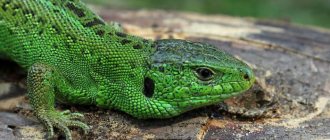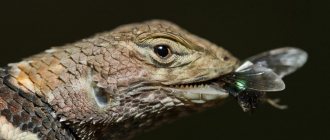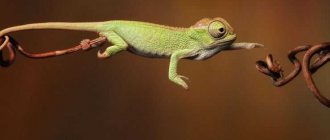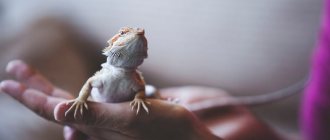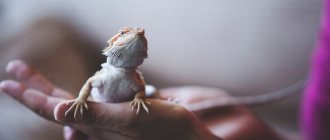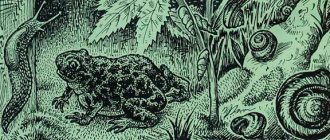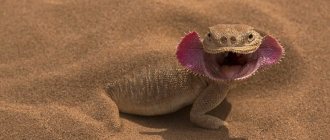Lizards are amazing reptiles. Most species (and there are more than 3,800 of them) are predators. Only a few are so-called “vegetarians”. Despite the fact that they are predators, for the most part they do not pose any threat to humans. Moreover, they can even become a true friend. It is for this reason that people often keep them at home, in specially equipped aquariums. And in today’s article we would like to talk about what lizards eat at home, in the wild, and what they should not eat.
Diet of wild reptiles
Lizards living in the wild obtain their own food. There are small and large species living on different continents, etc. But on average, their diet is the same:
- They feed on what they can find on the ground. Usually these are some kind of beetles, caterpillars or worms. Some species, the most dexterous, can catch insects such as flies, butterflies and dragonflies.
- They work in the gardens. The fact is that they really like Colorado potato beetles.
- The spindles have different preferences. These are lizards without legs that closely resemble snakes. These reptiles love earthworms, slugs, snails, and woodlice. They also prefer the larvae of various beetles.
- Lizards, like all living organisms, need vitamins. They get them by eating greens and vegetation, like cats and dogs.
- Naturally, they obtain water on their own, from streams, puddles, rivers and lakes.
Note: Lizards are quite voracious creatures. Common reptiles can eat the approximate daily diet of a large bird.
Natural enemies
Lizards, especially small ones, have a significant number of natural enemies due to their small size and the almost complete absence of defense mechanisms. Therefore, nature took care of reptiles, giving them the opportunity to defend themselves from enemies by dropping their tail, which remains in the hands or teeth of the enemy. After it is dropped, the lizard successfully slips out of the grip and hurries to run away as far as possible.
Moreover, each lizard has its own unique defense mechanisms, which differ depending on the species. For example, long-eared roundheads are capable of spreading their limbs wide and tensing their body, which together creates a terrifying pose when colliding with an enemy. If this fails to scare off an enemy, the lizard may use its teeth and claws in open combat.
Among the most characteristic enemies of lizards are the following:
Birds of prey like hawks, owls or eagles.
- Foxes.
- The Bears.
- Wolves.
- Snakes.
Sometimes even their own relatives, who do not mind feasting on smaller lizards, become a problem.
Homemade diet
If you have a reptile at home, then you can pamper it with insects such as flies, grasshoppers, crickets or worms. To prevent these insects from running all over the terrarium, you can first lightly squeeze them with tweezers.
They also love lizards and mealworms. Fishermen also call them bloodworms. Before serving such a delicacy in the terrarium, they first crush the head with tweezers.
Some lizards also eat beetles. But besides cockroaches, experienced lizard breeders do not recommend giving any other beetles. The fact is that they have a very rough shell.
If the lizard is large, then it can be fed with rats (small ones), mice, etc. You can also give small fish or pieces of fish and eggs.
Experts also recommend periodically feeding the reptile with cottage cheese.
Difference from snakes
Those types of lizards that do not have legs are almost the same in appearance as snakes. Such lizards include, for example, the copperhead, which many take for a snake, although in fact it is a lizard that simply does not have legs. But how can one distinguish such a legless lizard from real snakes?
Diet of different types
The sand lizard in the wild feeds on small snakes, grasshoppers, crickets, caterpillars, etc. At home, you can feed it with similar insects: grasshoppers, crickets, worms, flies, etc. It is also recommended to give her a mixture of carrots and pieces of meat.
Chameleons are most often fed cockroaches, flies and grasshoppers. To replenish vitamins in the reptile’s body, you need to give it a piece of banana, orange or other fruit. You can, of course, buy dietary supplements, but it is expensive and not as environmentally friendly as a piece of fresh fruit.
Geckos eat only live food: cockroaches, flies, grasshoppers, etc. Larger individuals do not mind eating mice or baby rats. You can also include quail eggs in your diet. There should always be water and bird stone powder in the terrarium. In the latter, insects are constantly encased before being fed to the gecko. This is necessary to replenish calcium reserves. You need to coat insects in powder daily, as well as give dry vitamins. But liquid vitamins are given once every 7 days.
It is very difficult to keep Moloch at home. All because of her selective diet. The lizard feeds only on ants and eats nothing else. At one time she can swallow up to 2500 insects. Naturally, keeping a moloch in a house is a very expensive business.
Skinks can be fed the same insects as the above species. They don't mind eating crickets, flies, and cockroaches. These reptiles are so picky that they even eat kitten and dog food.
The iguana is a purely herbivorous reptile. But this does not make its content simple. In the wild, it only eats leaves from trees. In captivity, it can be fed lettuce, spinach and cabbage. You can also supplement your diet with carrots and legumes. It is recommended to give fruits in small quantities.
Monitor lizards are the most unpretentious pets. These huge lizards eat not only live mice and insects. They don’t mind enjoying food with a “smell.” In captivity they are fed rats, mice, eggs, fish, cockroaches and the list goes on.
Common lizard breeding. Sanding lizard: reproduction
This type of lizard is widespread in southern England and Europe, as well as on the Balkan Peninsula, eastern France, Belarus, the Baltics, Asia Minor and Ukraine. The usual habitat for the sand lizard is dry, well-warmed steppes, forests and mountains of medium height.
Due to their color (greenish-brown or brown), they are perfectly camouflaged among grass and stones. As a place of residence, animals choose shallow burrows, depressions under stones or in the root systems of trees and large plants. Here lizards wait out the cold times.
Individuals usually live in pairs. There are some differences in color between males and males. For example, male animals are pale green or dark gray in color. Individuals living in warm regions surprise with their bright green color. Females are often inconspicuous: gray color predominates.
The young sand lizard has characteristic stripes along its back. Reproduction in animals occurs mainly during daylight hours in early spring. Males behave quite unusually during these periods: they raise their body above the ground on their front legs and begin to look around. In this way they find a suitable match for themselves. As soon as the male notices a suitable female, he immediately follows her.
His main goal is to grab the female by the base of her tail. Paradoxically, females do not throw back their tail at such moments, despite the pain. Then the male clasps the body with his paws and begins the mating process. Often during the mating season, nimble lizards organize fights for female representatives.
After the lizards have reproduced, the females begin laying eggs in late May - early June. On average, you get about 6-16 eggs. Future female cubs are buried in shallow holes dug previously. There is also an option when a fast lizard lays eggs in a shelter where it takes refuge. But it is also possible that mothers leave their nesting sites once and for all.
It is worth noting that the eggs of sand lizards are quite large, oval in shape and reach 1.5 centimeters in length. They contain a large amount of nutritious yolk, thanks to which the embryo develops.
What not to feed reptiles
In general, there are no restrictions in their diet. The only thing that needs to be observed is the “purity” of the food. For example, you cannot feed them cockroaches that you caught in the entrance. The fact is that they can be poisoned. The cockroach doesn’t care, they are used to poisons, but it will cause irreparable harm to our pet.
Also, it is not recommended to feed them field insects. Fields are often sprayed with insecticides against parasites, and these poisons can remain on the body of the bug. It is better to buy insects in pet stores, catch them in your garden, or in areas where chemical treatments are not carried out.
It is also advisable to feed lizards with moving insects, since most species do not eat dead food.
How to distinguish a male from a female?
Male and female lizards look almost the same, although there are a number of signs by which the sex of the lizard can be determined.
- In some species of lizards, such as basilisks and greens
iguanas, males have a bright crest on their back.
In general, all methods for determining the sex of a lizard are not perfect, and you can find out for sure whether it is a boy or a girl only through a testosterone test of the lizard’s blood done in a professional veterinary clinic.
Nuances
In order for a pet to live a long time, it is necessary to take good care of it. To do this you need to follow a few tips:
- You don't need to feed your pet right away in the morning. Usually, after waking up, lizards take a “bath” (wash themselves) and bask in the sun (an ordinary daylight lamp will do). Only then are they ready for breakfast.
- The terrarium should have a stable, moderate temperature. They cannot tolerate heat or cold.
- You cannot feed them during the day.
- At night you need to turn off the lights so that nothing disturbs them.
- If your pet has lost his appetite, then most likely the reason is the need for reproduction.
- In winter you need to increase the amount of vitamins. Otherwise, many species simply hibernate.
We hope our article helped you find out what lizards eat in nature and at home.
Herbivores or herbivores
The main type of food for this type of lizard is various fruits and vegetables, for example:
- Grape,
- carrot,
- cabbage,
- apples,
- lettuce leaves,
- potato.
However, it is allowed to give these products in mixed form. But when feeding potatoes, be careful, as this product contains many different nitrates. Before treating your pet, peel the skin of such food and cut into small pieces.
When eating food occurs, carefully watch the lizard and try to understand its taste preferences. Subsequently, it will be possible to take into account her tastes when thinking through her diet.
, offer every two weeks . Predators need to be given plant foods.
Habitats
Where do lizards live? Lizards live on all continents, with the exception, of course, of Antarctica. In general, they love warm climates and can be found in forests, meadows, steppes, and deserts in any part of the world. They move well on any surface and cling tightly to them with their paws.
Interesting fact: rock lizards are excellent jumpers; the height of their jumps can sometimes reach up to 4 meters.
Video
Author: Pavel Chaika, editor-in-chief of Poznavaika magazine
When writing the article, I tried to make it as interesting, useful and high-quality as possible. I would be grateful for any feedback and constructive criticism in the form of comments on the article. You can also write your wish/question/suggestion to my email [email protected] or Facebook, with respect, the author.
Author page
This article is available in English - Lizard.
